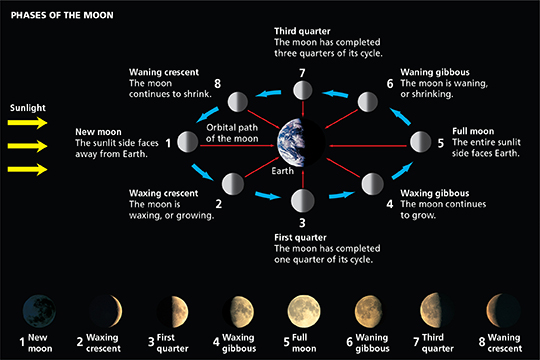The same side of the moon always faces Earth. This is because the moon makes one full rotation around its axis while making one full revolution around Earth. For this reason, whenever you look at the moon, its surface features are always nearly in the same place. Some parts of the moon may be in shadow, depending upon the particular phase, but the features you can see on its surface hardly move.
Eclipses
Imagine that it is the middle of a sunny day. Suddenly, the sky darkens and the sun appears to shrink. Animals act as if night has fallen. In ancient times, people were terrified of such occurrences, which are known as solar eclipses. An eclipse (ih KLIPS) occurs when the shadow of one body in space, such as a planet or moon, falls on another. For an eclipse to occur on Earth, the sun, moon, and Earth must all lie along a straight line.
You might wonder why eclipses do not occur twice each month, whenever there is a new or full moon. Eclipses occur much less often because the plane of the moon's orbit is tilted about 5 degrees with respect to the ecliptic. An eclipse occurs only when the moon crosses Earth's ecliptic plane at the time of a new moon or full moon.
Figure 8 Two different views of the phases of the moon are shown in this diagram. The circular diagram shows how the moon and Earth would appear to an observer in space as the moon orbits Earth. Note that the sun is shining from the left. The photos below the diagram show how the phases of the moon appear to an observer on Earth.
Interpreting Diagrams During which phase is the dark half of the moon facing Earth?






